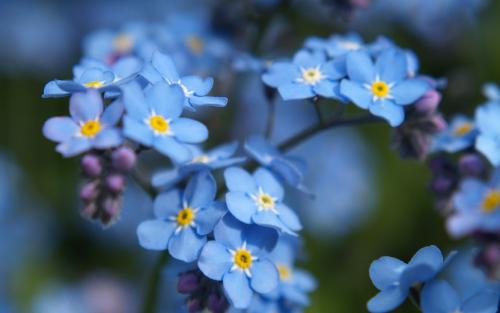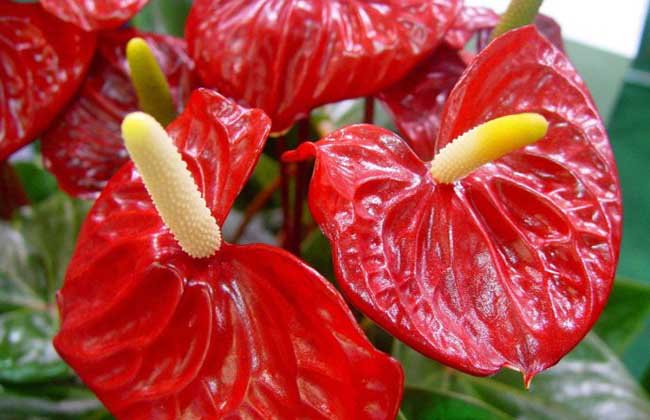Give to the ex-plant a "forget-me-not" send her forget-me-not flower profile conservation
Forget-me-not (scientific name: Myosotis sylvatica) is a plant of the genus Forget-me-not in the family Arneaceae. Forget-me-not is a perennial herb, 30-60cm tall. The flowers are 10-15cm long and have small blue flowers. The flowering period is April to May. Strong adaptability, like dry, cool climate, avoid damp heat, like light, drought resistance, growth temperature of 20℃-25℃.

Distributed in Europe, Iran, Russia, Pakistan, Kashmir, India and Jiangsu, Northwest, North China, Sichuan, Yunnan, Northeast and other places in the mainland of China. It grows from 200 to 4,200 meters above sea level. Most of them are born in mountain forest edge, hillside, forest and valley grassland.
In German legend, when God had finished naming all the flowers, an unnamed flower cried out,"Oh my God, please don't forget me!" And God answered,"That is your name."
Another story goes like this. When the Creator was about to finish giving color to all the flowers, he heard a little voice saying,"Please don't forget me!(Vergiss mein nicht!)"But there's only a little bit of blue left at this point. However, forget-me-not flowers happily accepted this light blue. This is where the blue flower gets its name.
Perennial herb. Stems erect, simple or several clustered, 20-45 cm tall, usually branched, sparsely spreading hispid, sometimes curly. Leaves mostly basal, flat on the ground; shortly stipitate, stipe winged; leaf blade obovate-spatulate, 8 - 10cm long, 3- 6 cm wide, apex rounded, base tapering into short stipe, margin microwave-toothed, pinnate veins evident below; cauline leaves opposite, 2 - 3 pairs, sessile, spatulate, 1.5- 2 cm long, 0.7 - 7cm wide, apex obtuse, base rounded, semiamplexicaul, margin undulate toothed.
Verticular cymes, 5-8 flowers per whorl, 2 bracteoles under each flower, bracts linear-lanceolate; pedicels 8 - 10mm long; calyx tube short, calyx 4-parted to base, lobes linear-lanceolate; corolla campanulate, cleft, pale green, 1 - 1.2 cm long; stamens 4, inserted in the curvature between corolla lobes, alternate with lobes; ovary incomplete 2-loculed, sessile, style short, glands verticillate at base of ovary.
Soil selection: forget-me-not likes dryness, deep soil layer, loose and breathable, slightly alkaline sandy loam, such as decomposed organic fertilizer and slow compound fertilizer. Plant spacing is 30cm × 40cm, planting depth is slightly higher than root neck, and the temperature should be kept below 15℃ for 2 months after planting, so as to facilitate the plant to pass the vernalization stage and facilitate normal growth and flowering.
Nutritional management: the total amount of fertilizer applied during the growth period, 70% of which nitrogen and potassium are applied as base fertilizer, 30% are used as topdressing, and all phosphate fertilizers are applied as base fertilizer. Topdressing is generally once a season. Applying potassium fertilizer and boron fertilizer at flowering stage is beneficial to improve the quality and yield of cut flowers. Forget-me-not likes dry and well-drained environments and avoids waterlogging. The amount of watering should be properly controlled throughout the growth period, otherwise it will lead to a decline in flowering quality and yield. Remember that!
Propagation technology: There are two ways of sowing propagation and tissue culture seedling. Sowing is generally carried out in September and January of the following year. The seeds are light repellent. After sowing, the seeds should be slightly covered with soil and kept humid. Germination takes 10~15 days at 15- 20℃. Sowing should pay attention to the temperature should not exceed 25℃, germination after the need for ventilation, seedlings with more than 5 true leaves when planting. Tissue culture seedlings cultivated by tissue culture technology were planted when 4~6 leaves were grown.
My personal experience: last year I planted two forget-me-not pots, not a few months to bloom, unfortunately, I planted the seeds too dense, the plant is not very tall, not strong, so when planting also pay attention to plant density.
Time: 2019-04-22 Click:
- Prev

Anthurium andraeanum-the most detailed maintenance experience of Anthurium andraeanum
Anthurium generally refers to AnthuriumandraeanumLinden (ornamental plant of Araceae) AnthuriumandraeanumLinden, perennial evergreen herb of Araceae. Stem nodes short; leaves arising from base, green, leathery, entire, oblong-cordate or ovoid. Petiole slender
- Next

When does Zixuan moon blossom and how to maintain it in order to burst the pot?
In recent years, succulent plants have become the first choice for many people to decorate interior space, and Purple Xuanyue is one of them. Purple Xuanyue is a very common indoor ornamental plant in our daily life, which has good ornamental value, so when does Zixuan moon blossom and how to burst the pot!
Related
- Fuxing push coffee new agricultural production and marketing class: lack of small-scale processing plants
- Jujube rice field leisure farm deep ploughing Yilan for five years to create a space for organic food and play
- Nongyu Farm-A trial of organic papaya for brave women with advanced technology
- Four points for attention in the prevention and control of diseases and insect pests of edible fungi
- How to add nutrient solution to Edible Fungi
- Is there any good way to control edible fungus mites?
- Open Inoculation Technology of Edible Fungi
- Is there any clever way to use fertilizer for edible fungus in winter?
- What agents are used to kill the pathogens of edible fungi in the mushroom shed?
- Rapid drying of Edible Fungi

